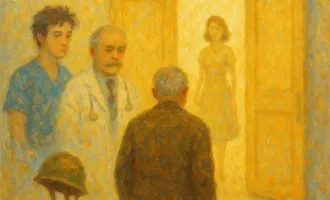
Trauma Junkie
First place winner in the Synapse Storytelling Contest for Fiction. Comments from category judge: An excellent piece of dystopian-realism, set in a familiar yet barely recognizable bleak landscape of San Francisco. I was plunged straight into the story by Collard’s precise and exhilarating storytelling. I also love how Collard manages to teeter right on the edge of the “uncanny valley”, blurring the line between our uncomfortable reality and probable future. I can’t wait to learn how the story unfolds!
It’s Christmastime, and over the hills, in the faraway furrows of one of those endless tracts of half-submerged land, a main battle tank sits in a ditch, decomposing, festering. My tank. But the neighborhood seems to have forgotten, here in the shadow of the old Hospital, that shining ziggurat high above. An aspiration, once — and an obligation.
Now it is only a reminder. A reminder of its offices emptied during the Reunification. Of the price of dissent. Of the swaying bodies of the Institute faculty on so many videos. I remember early in the War — remember the bitter, horrifying thrill of turning on my American friends’ VPN to see those videos, unsure if they were real, not caring if they were real.
These days, it seems difficult not to see them. We are meant to see them now.
The sun peeks out over the top of one of the short, older buildings along Irving. After the ’49 Revolution, most of the Avenues got Reclaimed — just row after row of concrete and glass, that iconic style of the Communist residential blocks. But this part of town was always nice; it got some cultural protection during the Old Regime, and never got built up like the rest of the Sunset.
Our old money is worthless now. That’s fine enough for me; my work was always online and international anyhow. But a lot of my friends working for the big State enterprises — Apple, Tesla, Amazon, Uber — they really took a hit when the currency collapsed. I pull out my wallet and look for some cash to pay for my morning coffee.
Five dollars, I think. Right, that’s about what coffee is.
Even six years out, I’m not quite used to the mental gymnastics of how much an American dollar is. I hand over the bill; it feels in my hand like worn cloth, a shred of someone’s shirt put through the wash too many times. We used to pay with our phones; we had for years.
All at once, I’m taken with a thought:
I can’t believe we lost to these people.
I give the bill over to Ezra, who’s been running this spot since I moved to the neighborhood. He isn’t political. His business involves putting things in hot water, and putting hot water through things.
“You want that for here or to take it?” he asks, kind, genuine. He has a thick mustache and subtle stubble everywhere else. It’s a look that’s in right now. I hate it, but I’m the odd one out.
“No, I’ll take it. That’s fine.”
Ezra hands me back a small paper cup, two bills, and some coins. There’s a little glass jar on the counter next to a case with some croissants and an oatcake. I made a mistake getting the oatcake a couple years ago. I drop the coins into the jar; it’s an odd ritual, but one I’m getting more used to.
I walk down the block toward the subway stop.
It’s Saturday, I think. Why am I going in on a Saturday?
But here I am — not so much consciously, more of an automatism. It’s nice to be moving, more than anything. To have a place and time to go to that isn’t here and now. I walk down the steps, over their clicky metal tops. The walls are covered in ceramic hexagons, shaped to create this beautiful illusion where you can’t tell if they’re curved inward or outward. I remember appreciating that detail when I first moved here. But now I see a couple of them are cracked, and it gives the whole thing away: they’re definitely bubbled out.
The platform really used to be something, I imagine, back in the ’60s when the Old Regime built all the metro infrastructure. That iconic State architecture, clean and grand: the enormous concrete tube, lit edge-on in eerie, dim reds accentuating shadows cast by perfect imperfections in the intentionally unfinished wall. The long benches, austere rectangles of oak. The warm glow from enormous domes hanging overhead, matte black eggs with cream interiors. Even now, it looks like the future.
Except that now, there are homeless. A black man in a soiled red puffy jacket and a grey beanie is curled up on one of the long benches next to me as I wait. His mattress is a cardboard box, haphazardly split open to be somewhere close to the right dimensions for sleeping. Next to him is a black trash bag, full to bursting, contents unknown. I am uncomfortable.
Then a distorted bell; a woman’s voice:
“Now approaching: eastbound C to Fisherman’s Wharf.”
That was one of the first things they Made Great, the Muni voice. They used to have Spanish, Cantonese, Tagalog. I guess that one wasn’t so hard: all the announcements are software-generated. But when you ride twice or four times a day and hear those same voices, you get used to them. They’re odd friends. I used to work at a company in Hong Kong, and I was pretty shit at the language, but it always made me smile that I was good enough to get the subway announcements here at home. It reminded me we were part of a world.
Now even the English voice is a little different. Professional, sure. But also uncanny. Grotesque. Sexual. Bizarrely sexual. And white — very, very white.
The train rolls in, and the glass dividers open, beckoning to me and the one other person floating through on a Saturday morning, four cars over. I sit myself down on a long bench, solitary, and look up at the display. There are three trains bunched up ahead of this one, and an ad for Denny’s. Someone has keyed something into the polished steel frame, but the para-language hieroglyphs don’t mean anything to me. MTA used to be pretty good about polishing those things out, but whoever they got sold off to during Privatization realized they don’t have to care anymore.
The eight cars of the train are all connected by accordion umbilicals, and I look to the right, through their rugae. The endless tube spasms and sways. A few meters from me, in a jumpseat next to the nearest umbilical, a skinny man is nearly a corpse, legs splayed out in front, head drooped to the side. I crane my neck to take a closer look at him: the crusty black hair, the lesions around his fingernails, the urine stains running down his grey bathrobe. But most telling are his eyes. Those wide, empty eyes. The eyes of a draugr — pupils constricted to a pinprick.
I look down at the floor in front of me and sigh. A rogue Diet Coke bottle darts out from underneath my bench as we take a turn.
We must be crossing the Park; less than a minute to Geary, I think.
I look back at the man, and the details flood in. His skeleton. His still diaphragm. The small black dot tattooed below his right ear — his Neuralink conduit. I wonder if he was on the Front, or if he was one of the remote mech operators stationed at JPL. The Remotes had it bad — doing a 9-to-5 slaughter, and then going home to your kids. It got worse when Defense figured out that adding pain to the percepts increased unit effectiveness.
I look down at my watch: a little past 8:30.
“Shit,” I whisper. I know the Geary stop’s probably empty.
I drop the shoulder strap of my backpack, and zip open a compartment on the side where I keep my stims. I pull out the two polished silver discs, and keep them tight within my fists.
What’s happening to this city? I think, already parallelized; most of my brain is planning.
I get up and walk over to the man. I kneel and put my palms on either side of his head, stims behind the ears. I close my eyes. The discs ping him with a flurry of imperceptible pulses, and in my Sight, the circuit map starts to fill in — the fuzzy clouds of his axonal tracts, the superhighways within his skull. I hate that I’ve gotten so good at reading these tensor fields; I only learned to be a good Samaritan. But even with the best renderer, the seven-dimensional percept still feels like a Psilorex trip.
I wade into him, feeling around for his retrosplenial cortex. A good segmentation takes five or six minutes, but Inside, the dilation is about eightfold. And it’s worth it to be careful.
There.
I have it, that little bundle deep in the back of this poor guy’s noggin. It feels almost like reaching into a vat of soft tofu and pulling out a nugget of firm. I stretch through the data-soup with my third arm — the stims’ electromagnetic field steering — and give the chunk of brain a tap.
I open my eyes, 40 seconds later. The train pulling in. The empty platform through the windows.
I pull the man’s arm over my shoulder and look back at his face. His eyes are blinking — that’s a good sign. But he’s not going to be happy in a minute. The doors to the subway car open; I hobble with him out onto the platform. I lay him down quick, and dash over to the thin column in the center of the cavernous station. I press the blue nub with my index finger, and the emergency speaker starts sputtering to life.
The new Oligarchs probably don’t bother to repair these either, I think. Why would they — can’t imagine anybody has pressed this since before the War.
Half a minute passes, dilated now by adrenaline.
“Yes?” The operator’s voice comes over the intercom, almost unintelligible in the ocean of static.
“Stop! Don’t shoot!”
I look down at the man. He is still sitting on the yellow bumpy line where I dropped him, but now upright — hands straight to the sky, arms about to be liberated from their sockets. His terrified grey eyes are off in outer space, down toward the end of the platform, imploring no one.
“Hey, you’ve gotta send some EMTs down here,” I tell the grating next to the blue light. “This guy was Dreaming on the eastbound C train. I think he’s getting shot by the cops or something.”
“Ok, we’ll send someone to investigate——”
“Please, I’m unarmed!” the man yells. I start to sweat.
This isn’t a good look. My eyes turn to the open Muni car doors, inviting.
“Just stay where you are, and we’ll have someone there soon,” the intercom resumes. “Can you give me your name?”
The door alarm starts squawking; that one they haven’t changed since the ’60s. I hop back toward the train, over the man’s legs.
“Sorry — I didn’t catch that!” I yell back behind me. The doors start closing, but I shove my arm in the gap.
“Please stand clear of the doors,” the sexy woman’s voice returns. The panels slide back, freeing me; I rush forward into the subway car.
And then the man on the floor behind me screams.
I close my eyes. I feel myself as I leave my body. It is a scream I know. An endless scream outside of time. A scream that pierces, that fractures, that liquefies and evaporates. The scream of men in combat. My men. Grey eyes. A shoulder patch — the star, the grizzly bear. The smell of burning meat. My tank. The black smoke shrouding the mountains above. The black reflection in the vast wet grid of the valley below.
I look out from our position. In my Optics, I see the wall of American armor cutting through the infinite expanse of blossoming almond trees, a tornado of white petals and fire. An enemy F-35 buzzes us, and we feel it in the ground as much as the sky. There is nowhere to hide, nowhere to run to. I reach down and feel the cold steel.
My home. My fortress.



